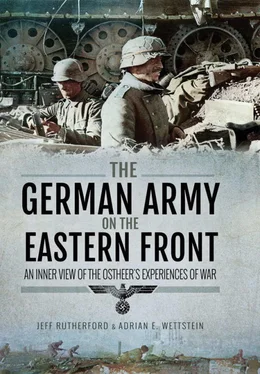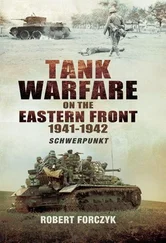Even though we have written out most of the less well-known abbreviations, the numbering of military units has been included. German units are normally numbered as follows: companies, regiments, divisions and armies in arabic numerals, battalions and corps in Roman numerals. So, for example, 3./203 refers to the 3rd Company of the 203rd Regiment while, III./203 would be the 3rd Battalion of the same regiment. To avoid unnecessary complication, we decided to translate all battalion-size units with the term battalion (German artillery, artillery related, and mobile units used Abteilung instead of Bataillon ). Manpower strength numbers are typically given as, for example, 1/7, which means one officer and seven men. In a few cases, this ratio is different, but it is explained in the text.
One of the great pleasures for professors is to teach engaged, intellectually curious students. Both of us have had this opportunity in our respective institutions and it was our discussions with them about the German army and its war in the east that convinced us to undertake such a project. We hope that this book will provide a good introduction to the Germany army on the Eastern front, not only in terms of basic knowledge, but also in developing an understanding of the sources, which helps to overcome textual difficulties and also connects them across time and space.We therefore dedicate this book to our students. In Wheeling, the history majors at Wheeling Jesuit University have generally been an outstanding group, but three stand out and this book is dedicated to them: KM, JZ, and ET. In Zurich, most of the candidates at the Federal Military Academy at the ETH Zurich shared a deep interest in military history and keenly discussed issues that were essential for their professional formation. This book is especially dedicated to RG, NJ, PS and SB. The authors would also like to publicly thank Ben Shepherd, Marco Sigg and David Stahel for providing documents and photographs for this volume.
Chapter 1
Combat on the Eastern Front
During the Second World War, the decisive theatre of war for the German army was the Eastern front. Perhaps the most effective way to measure the importance of this front for the German war effort is by looking at the army’s casualties in the east. According to the historian Stephen Fritz, the Germans suffered over 3.5 million dead fighting the Red Army, with another 363,000 dying in Soviet POW camps. This total meant that ‘almost four of every five German military deaths thus came at the hands of the Red Army.’ [1] Stephen Fritz, Ostkrieg: Hitler’s War of Extermination in the East , p. 470.
The Germans inflicted much heavier casualties on their Soviet adversaries, with 11.5 million the generally accepted number of military deaths, though other estimates reach upwards of some 25 million. [2] Ibid., p. 471.
These numbers – which far and away dwarf those from the Western Allied-German conflict – not only suggest that the German-Soviet war was the largest and deadliest theatre of war, but they also highlight the German army’s primary goal during the conflict: defeating the Red Army on the battlefield. This seemingly obvious point, however, has been somewhat lost in the recent historiography which has focused – rightly – on the accompanying war of extermination waged by the Nazi state. While the Third Reich’s ideological war will be examined in chapters 5and 7, this chapter will examine the army’s struggle on the field of combat and the success, as well as the trials and tribulations it suffered during the little more than three years of war within the borders of the Soviet Union. [3]
German planning for the invasion of the Soviet Union was based upon two fundamental ideas. First, success in the campaign would depend on the panzer divisions, concentrated in panzer groups, driving quickly into the interior of the Soviet Union and destroying the bulk of the Red Army before it could retreat behind the Dvina and Dnieper rivers. Following this initial operational phase, the army would then carry out a mopping-up of the shattered Soviet forces, eventually pushing what remained behind the Ural mountains. [4]Second, the army possessed a not entirely mistaken belief in its superiority vis-á-vis Soviet forces. Germany’s blitz victories over a whole series of opponents in between 1939 and 1941, but especially its shocking defeat of British and French forces in 1940, generated a true self-confidence throughout the army’s ranks. This was contrasted by the Red Army’s poor performances during its 1939 occupation of Eastern Poland and, more importantly, during the 1939–40 Winter War with Finland. The confidence, even hubris, with which the army approached the eastern campaign thus led to a criminal underestimation of Red Army capabilities, as well as a negligent attitude towards issues of intelligence and supply (see chapter 4for a thorough analysis of the latter point). From the German perspective, the army’s superiority at the operational and tactical level would ensure a quick and decisive victory, making other considerations secondary at best. [5]
On 22 June 1941, some three million German and allied soldiers invaded the Soviet Union, the largest invasion in history up until that point. On the macro-level, German forces achieved success along the entire breadth of the front, from the Baltic States to Ukraine. With the exception of Army Group South, whose initial advance was more pedestrian, German forces, particularly the Panzer Groups attached to Army Group Centre, plunged deep into Soviet territory and not only reached their initial geographic goals, but destroyed numerous Soviet armies in the process. [6]The following battle report compiled by Panzer Group 3 highlights both the unit’s role in the Minsk battle and the conflict that emerged at the upper levels of the German army concerning the employment of armour: should manageable encirclement battles be waged in succession, or should the panzers drive as deeply into the Soviet rear as possible in an attempt to completely dislocate the Soviet defence? [7]
The border heights were quickly taken. […] On all places along the front, only minimal enemy resistance was reported. Only a very few prisoners, all of whom were completely in the dark about the beginning of the war and the situation.
The question arose at the Panzer Group if the German attack really was a complete surprise for the Red Army or if the enemy had pulled back some of his forces from between the border and the Niemen [River] to the east under a wide-ranging radio deception.
Gradually, the evidence increased during the course of 22.6. That still stronger enemy forces existed west of the Niemen than at first presumed. If the reported divisions existed in full strength or only partially [as they were] still in the process of formation, because they were too poorly armed, remained unclear. It was determined that these elements were without live ammunition, allegedly released for an exercise.
Where the enemy chooses, he fights tenaciously und courageously until death. Deserters and surrender has been reported by no command. The struggle became therefore harder than in the Polish and the Western campaigns.
As in Poland, the enemy was driven into the forests by our air attacks, from which he conducts a successful guerrilla war against rear elements and [supply] columns. This may also be a reason for the initially surprisingly small appearance of enemy forces. How much of them are hidden in the forests and how much equipment that they were forced to leave in them cannot be overlooked yet. […]
From Vilna to Minsk
During all discussions for the Barbarossa deployment, there existed differing conceptions about the continuation of the operation after the crossing of the Niemen for Army Group B and Panzer Group 3. Panzer Group 3 had the intention to push on to the Dvina [River] on the nearest road without turning to secondary issues too quickly. The intention of the OKH [8]to create the prerequisite for the destruction of the enemy between Bialystok and Minsk with Panzer Group 2 and 3 would have been better achieved, in the view of Panzer Group 3, through a thrust to the Dvina to prevent withdrawal and new resistance there, than [through a thrust] with the narrowly pinned goal on Minsk. The army group left the decision open before the beginning of the attack and ordered an intermediate objective Molodeczno-Narach Lake to proceed either to Minsk or to Vitebsk-Polotsk.
Читать дальше






![John Stieber - Against the Odds - Survival on the Russian Front 1944-1945 [2nd Edition]](/books/405234/john-stieber-against-the-odds-survival-on-the-russian-front-1944-1945-2nd-edition-thumb.webp)





